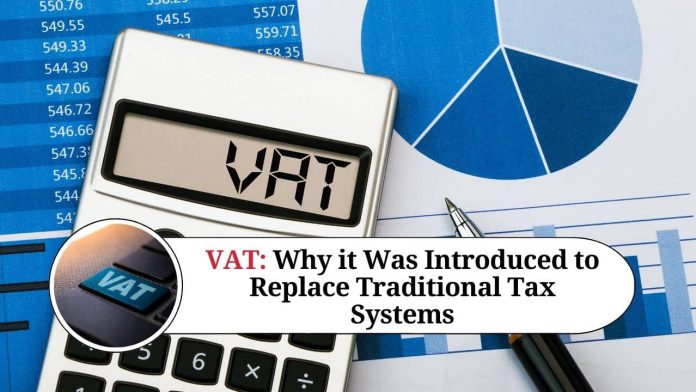Introduction:
Value Added Tax (VAT) is a tax system that is used in many countries around the world. It is a tax on the value added to goods and services at each stage of the production process, from raw materials to the final product. VAT is seen as a more efficient and transparent system compared to the previous sales tax system, and it is believed to generate more revenue for governments. In this blog, we will discuss the reasons why VAT is introduced and the benefits it offers.
Why is VAT introduced?
VAT is introduced in many countries as a replacement for the previous sales tax system. There are several reasons why VAT is considered to be a better tax system than sales tax:
- More Transparent: VAT is considered to be more transparent compared to sales tax because it is a tax on the value added at each stage of the production process. This means that businesses can see exactly how much tax they are paying and how much they can claim back. This transparency makes it easier for businesses to comply with the tax system and for governments to monitor tax compliance.
- Reduced Tax Evasion: VAT has been introduced to reduce tax evasion. Sales tax is easier to evade because it is only collected at the final point of sale. VAT, on the other hand, is collected at every stage of the production process. This means that businesses cannot avoid paying tax by underreporting sales or not declaring their income.
- More Revenue: VAT is believed to generate more revenue for governments compared to sales tax. This is because VAT is a tax on the value added at each stage of the production process, which means that it is applied to a larger base of economic activity. This larger base of economic activity means that more revenue can be collected from the same tax rate.
Benefits of VAT:
- Fairness: VAT is considered to be a fairer tax system because it is a tax on consumption. This means that people who consume more pay more tax, which is seen as a fairer way of raising revenue.
- Encourages Compliance: VAT is believed to encourage compliance because businesses have an incentive to keep accurate records and pay the correct amount of tax. This is because they can claim back the VAT they pay on their inputs, which means that they only pay tax on the value they add to the product or service.
- Encourages Investment: VAT is believed to encourage investment because businesses can claim back the VAT they pay on their inputs. This means that they have more cash available to invest in their business, which can lead to increased production, job creation, and economic growth.
How VAT Works:
VAT is a tax on the value added to goods and services at each stage of production. For example, let’s say a manufacturer purchases raw materials for $100 and adds value by turning them into a finished product, which they sell to a retailer for $150. The value added by the manufacturer is $50. The retailer then adds value by selling the product to a consumer for $200, with a value added of $50. The VAT rate in this example is 10%.
The manufacturer would pay $10 in VAT to the government (10% of $100), and the retailer would pay $5 in VAT (10% of $50). The retailer would then charge the consumer $220, which includes the $20 in VAT that they paid to the manufacturer and the government. The consumer would not be able to claim this VAT back.
Types of VAT:
There are several types of VAT, including:
Standard rate: This is the rate that applies to most goods and services.
Reduced rate: This is a lower rate of VAT that applies to specific goods and services, such as food, children’s clothing, and energy-saving products.
Zero rate: This is a 0% rate of VAT that applies to certain goods and services, such as basic food items, medical supplies, and books.
Exempt: This means that no VAT is charged on the goods or services. Examples of exempt items include education and health care.
Impact of VAT on Consumers:
The impact of VAT on consumers depends on the country and the specific goods and services being purchased. In some cases, the VAT is included in the price of the product or service, so consumers may not be aware that they are paying it. In other cases, the VAT is added to the price at the point of sale. Consumers may feel the impact of VAT more when it is added on top of other taxes, such as income tax or property tax.
In general, VAT is considered to be a fairer tax system than sales tax because it is a tax on consumption, which means that people who consume more pay more tax. However, VAT can be regressive, meaning that it has a greater impact on low-income households because they spend a higher proportion of their income on goods and services.
Conclusion:
VAT is a tax system that is used in many countries around the world. It is a tax on the value added to goods and services at each stage of production and is considered to be a more efficient and transparent system compared to the previous sales tax system. VAT is believed to generate more revenue for governments, encourage compliance and investment, and be a fairer tax system. However, the impact of VAT on consumers can vary depending on the specific goods and services being purchased and the tax system in the country.
Read more useful content:
Frequently Asked Questions (FAQs)
Q1.) What is VAT?
VAT stands for Value Added Tax. It is a tax on the value added to goods and services at each stage of production.
Q2.) How is VAT different from sales tax?
Sales tax is a tax on the final sale of a good or service, while VAT is a tax on the value added at each stage of production.
Q3.) Which countries use VAT?
Many countries around the world use VAT, including the European Union, Canada, Australia, and India.
Q4.) Who pays VAT?
Businesses pay VAT on the value added to goods and services at each stage of production. Consumers pay VAT when they purchase goods or services that have VAT included in the price.
Q5.) What is the VAT rate?
The VAT rate varies by country and by the type of goods or services being sold. In some countries, there are multiple VAT rates, such as a standard rate, a reduced rate, and a zero rate.
Q6.) What is the difference between a reduced rate and a zero rate of VAT?
A reduced rate of VAT is a lower rate of tax that applies to specific goods and services, while a zero rate of VAT means that no tax is charged on the goods or services.
Q7.) How do businesses claim back VAT?
Businesses can claim back VAT that they have paid on their inputs (such as raw materials and services) by offsetting it against the VAT they have charged on their outputs (such as sales of goods and services).
Q8.) What is the threshold for VAT registration?
The threshold for VAT registration varies by country. In the UK, for example, businesses must register for VAT if their taxable turnover is over £85,000.
Q9.) What happens if a business does not comply with VAT regulations?
If a business does not comply with VAT regulations, they may be subject to penalties and fines.
Q10.) How does VAT affect the economy?
VAT is believed to be a more efficient and transparent tax system compared to sales tax, which can have a positive impact on the economy. However, VAT can also be regressive, meaning that it has a greater impact on low-income households.




















